Sometime in 1973, I began paying attention to newspaper articles about the continued exploitation of farm workers,
and at a house meeting with the veteran peace activist Blase Bonpane, I learned more of what Cesar Chavez and the
United Farm Workers Union were doing to bring some measure of economic justice for farm workers. Later, I
re-connected with an old high school pal, who with his twin brother had worked as a lawyer for the UFW in the
late '60s. In spring of 1974, Peter and I went to the Coachella Valley for the kickoff of the new grape boycott.
That clinched my growing committment to do what I could to promote the UFW's cause. Peter reckoned that he might
go back to work for the union. We then lost touch with each other, but, happily, were to meet again.
I began distributing materials about the grape boycott at my UCC church in Woodland Hills, California, and so as
to learn more about the
issue first-hand, I spent a week in August with the UFW in the southern San Joaquin Valley. There I traveled with union members
to the fields where they picketed the illegal aliens who had replaced them for the harvest. My trip was arranged by
Presbyterian minister Chris Hartmire, then the Director of the National Farm Worker Ministry, and one of the few
living saints I have been privileged to meet.
Below I present some of the photographs I took of my experience. Sadly, in those days I didn't have a
particularly good camera, nor did I have a flash to illuminate dark, or strongly back-lit subjects.
(I didn't really know how to use a flash properly in any case.) Thanks to my trusty scanner, and
modern photoprocessing software, however, I've been able to improve a bit on some rather poor examples of the
photographer's art. Whatever notes I took disappeared long ago.
The history of Californa agribusiness's battle against fair treatment for farm workers is sordid, and too complex to
deal with on these pages. Suffice it to say that many of the gains made by the UFW during Governor Jerry
Brown's tenure have
been seriously weakened, if not erased, by subsequent grower-friendly governors. After 40 years, it is still
difficult for farm workers to gain, and keep, union representation.
 # 1.
# 1.
Clinic for farm workers on the southern outskirts of Arvin, funded by what was then the
Dept. of Health, Education, and Welfare.
My great 1967 Dodge Dart is parked in front, with pro-UFW bumper stickers, if memory serves. I seem to remember
taking them off at the advice of UFW members. Arvin is near the town of Weed Patch, which in the '30s was a destination of
hundreds of poor "Okie" families who had fled their hard-scrabble farms in the Dust Bowl. Weed Patch became the somewhat
unwilling host to a large federally managed farm labor camp, of the type immortalized by John Steinbeck in
Grapes of Wrath.
The story of the development of the Weedpatch Camp's school, in response to the shameful treatment of the Okies and
their children by their Kern County neighbors — virtually all of them pious Christians — is beautifully told by Jerry Stanley in his book
Children of the Dust Bowl: The True Story of the School at Weedpatch Camp. (Crown, 1992.) Through the love and compassion of a dedicated principal and
his idealistic teaching staff, the school
became so successful that the same parents who had earlier looked upon the migrants with contempt begged the administrators
to allow their children to attend. If you know a film-maker looking for a powerful and inspiring story,
deserving an all-star cast, this is the one.
For links to more information on the creation of the Weedpatch Camp School,
see Dust Bowl Festival.
 #5.
#5.
Bulletin board at the Arvin UFW office. The yellow sheet shows deductions to M. Peña's weekly gross pay,
leaving him with only $30.16 for a week's work. "Coyote" is the term for the person whom an illegal immigrant
pays to get him or her into the U.S. for work, usually over the U.S.-Mexico border. It seems likely that
the fee owed the coyote by the worker was paid in full by his or her U.S.-based handlers, and was paid
off in weekly
installments. It seems odd, though that a line item for such a charge would show up on the worker's pay slip, rather
than being subtracted from the weekly gross. It may be that this sheet is only a representation of
deductions taken from señor Peña's gross pay, and that he received no paper record at all.
Either because I was no better a reporter than a photographer in those days, or because I didn't want to appear
skeptical, I didn't ask about that.
 # 6.
# 6.
Strike-oriented art. Mexico has produced perhaps the world's greatest muralists, and the heritage is apparent
in the abundant small murals created by farm workers themselves. It was widely believed that the Teamsters Union
had signed "sweetheart" contracts
with many of California's growers in their common effort to break the UFW.
 # 7.
# 7.
 # 8.
# 8.
 # 10.
# 10.
Farm worker housing.
 # 11.
# 11.
I never believed the sign. If memory serves, the date (unreadable here) was after the harvest in the Arvin
area was over. It is a virtual certainty that people lived in these "prohibited" buildings during the harvest.
 # 13.
# 13.
 # 14.
# 14.
 # 17.
# 17.
A bunkhouse.
 # 18.
# 18.
A bath house. The following two photos are of the inside of this structure.
 # 19.
# 19.
 # 21.
# 21.
 # 23.
# 23.
Graffiti on a "bedroom" wall.
 # 28.
# 28.
A bunkhouse on farm property. If memory serves, this is where
I obtained permission from a ranch foreman
to speak with a few of the workers who were relaxing around the bunkhouse. They
were not particularly unhappy there. One man felt the overseer was a pretty good guy
because he allowed them to have a refrigerator and a hotplate in the bunkhouse.
(Many years later,
while on a bike ride through the lima bean fields of Camarillo, California, I stopped and asked the farm
workers what they thought of the UFW's efforts to organize farm labor. One of them volunteered that he
didn't think much
of Cesar Chavez because Chavez drove around in a big Cadillac. I didn't ask him where he got that wildly
mistaken idea.)
 # 30.
# 30.
A mural at La Paz, UFW headquarters at Keene, California. Cesar Chavez is
depicted front center.
 # 33.
# 33.
La Paz. Shelf holding folders containing medical plan information for UFW members. Another
such shelf is seen against the back wall. If memory serves, the medical plan for
the farm workers was named after Robert F. Kennedy. UFW members from Mexico
also had medical coverage, which could be used in Mexico.
 # 34.
# 34.
First morning on the picket line. Lots of color.
 # 36.
# 36.
Buses like this are owned by labor contractors, who drive the farm workers
to and from the farms. I don't know whether all farm workers so transported
lived in housing provided by the labor contractor, or whether some lived outside
of the labor camps, and hitched a ride with the bus as it made its rounds.
 # 37.
# 37.
A smaller bus. This one looks safer than the large one.
 # 41.
# 41.
Packing grapes. The man in the brown checked shirt is the labor contractor,
and the man in the blue jacket is the Teamster overseer for the crew.
The Teamster didn't do a lick of work, so far as I saw, unlike UFW stewards,
who work just like everyone else. We will never know whether
this guy was there to make sure that no worker was "exploited," or to make
sure that no one got out of line.
 # 43.
# 43.
I was told by my UFW guides that this was farm worker housing owned by the contractor in
the previous picture. Pretty nice.
 # 45.
# 45.
Other housing, not too far away. This complex was pretty much empty at this time,
as I recall.
 # 50.
# 50.
We drove through this large complex. My UFW guides said that it was best for us not to
get out of the car.
 # 54.
# 54.
Kids at "home" while dad is at work. Mom was nearby. The little girl's
hands were covered with warts. The UFW member in the doorway said that he
would bring a UFW nurse out to see the family the next day.
 # 60.
# 60.
These mobile packing tables, with shade, were common.
 # 63.
# 63.
There was a time when the growers provided no porta-potties,
and farm worker had to relieve themselves in the same fields
they were harvesting.
 # 65.
# 65.
The Teamsters Union decided to "compete" with the UFW for the loyalties
of the overwhelmingly Hispanic farm labor force. I don't know for whom
this sign is intended—certainly not the
end consumer, or even the market owner. It was probably Teamster PR
directed at their many critics who were observing conditions in the
fields that turbulent summer.
 # 65t.
# 65t.
Close-up of Teamster "assurance" that these farmworkers "insisted" on
Teamster representation. I of course didn't believe that for a moment.
If unions and management collude, it is easy to ensure that workers will "vote"
for the union chosen.
After 40 years, it would be
interesting to examine the records to see what health, vacation, and
retirement benefits were actually
distributed to these Teamster-led workers. (In truth, my skepiticsm
ran far deeper than that, but when
dealing with the Teamsters, one must watch one's step. I'll let the
visitor guess what my real sentiments were.)
 # 66.
# 66.
Someone let the air out of all four tires on this farm foreman's truck.
 # 68.
# 68.
This is an entirely Arab work crew. On my first day, I heard Spanish,
Arabic, and three dialects of Tagalog, the indigenous Flipino language.
These Arabs were in the U.S. legally. Most, if not all, Hispanic strike-breakers were
illegals. Union spokesmen called out to the strikebreakers, not to urge them to
strike, because the UFW knew that they had even fewer options than union members.
The UFW simply wanted to foster an awareness of the real farm labor situation in California.
Not once did I
hear even a trace of abuse from the UFW spokesmen, who spoke respectfully
to the strikebreakers through a portable PA system. I saw more than one shy smile
from a campesina at a packing table in response to some gentle joke made by the UFW
spokesman.
Immediately after this picture was snapped, the Arab workers pushing the cart somehow
"lost control" of it, and it tipped over into the ditch, making it unuseable at least
for the moment. There were gales of laughter from everyone on both sides of the invisible wall
that separated the workers from the strikers.
 # 71.
# 71.
The man in the orange vest, left, is an observer from one of the mainstream
Protestant church organizations. He was very
careful to express a strictly neutral opinion on the labor controversy.
 # 76.
# 76.
There was some sort of altercation here, but I don't recall what caused it,
or just who was involved. The man in the blue shirt with his back to the
camera is Pablo Espinoza, then and still an employee of the National Farm Worker Ministry.
Pablo was "in charge" of me during my visit to the Arvin neighborhood.
 # 77.
# 77.
Children still work in the fields.
 # 81.
# 81.
Some recreation. Songs of solidarity.
 # 83.
# 83.
The singer in the previous frame crossed the street to offer some
grapes to a Kern County Sheriff's deputy and an unidentified photographer.
I got the strong impression that the photographer was also with the sheriff's
office, because he had earlier made a very conspicuous point of photographing
me. I immediately reciprocated, and took an equally conspicuous picture
of him, which I do not show here.
 # 84.
# 84.
My buddy Phillipe. Phillipe was Filipino, and had come to the Valley as a young
man in the '20s. He had worked at a variety of trades, and said that as a barber
he had cut the hair of just about every grower in the San Joaquin Valley.
He told of the early strikes by Filipino workers, where the strikers would
fill their pockets with salt to throw in the eyes of the sheriffs and
goons hired by the growers to break their picket lines. The young Filipino
men who were brought to California by the growers were forbidden by law to
marry American women. But, they were a scrappy bunch, and early on fought for
fair pay and decent working conditions.
 # 85.
# 85.
Taking a break. The young man isn't sure whether this Anglo with the camera
should be trusted. I don't blame him.
 # 86.
# 86.
Pablo Espinoza and an unidentified co-worker. A compañera has prepared
some food for the stikers.
 # 87.
# 87.
Victory.
 # 88.
# 88.
These are the oldest surviving Filipino workers, no longer able to work.
They are being housed at a large ranch while they wait for the UFW retirement
home to be completed. They will be its first residents.
 # 90.
# 90.
The Service Center at 40 Acres, the UFW compound in Delano.
 # 91.
# 91.
Service Center Entrance. One of the first people I met when I entered
was Peter, who had indeed gone back to
work for the UFW. I arrived just in time to accompany him and the
rest of
the legal team on a weekend break to Buellton, where a rodeo was in
progress. From there we went to the then-sleepy beach town of Cayucos,
where we spent the night under the pier. I stayed with Peter and his
friends for the remainder of my time with the UFW. The lawyers worked
in the office, and I went out with the pickets in the Delano area.
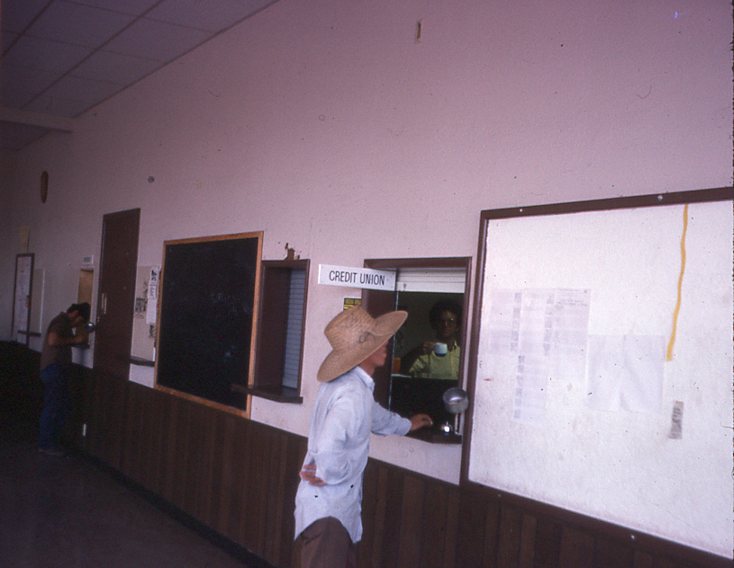 # 92.
# 92.
I have had this photo of Peter (behind the glass, with his cup of coffee) for years,
but I did not want to post it publicly, out of a certain caution. Peter passed away
unexpectedly in December 2021, and I now feel comfortable showing him as he lived his life---fighting for the underdog.
 # 93.
# 93.
Bulletin Board. Very subversive, to give common laborers access to information.
 # 95.
# 95.
The regular morning meeting to strategize the day's picketing activity.
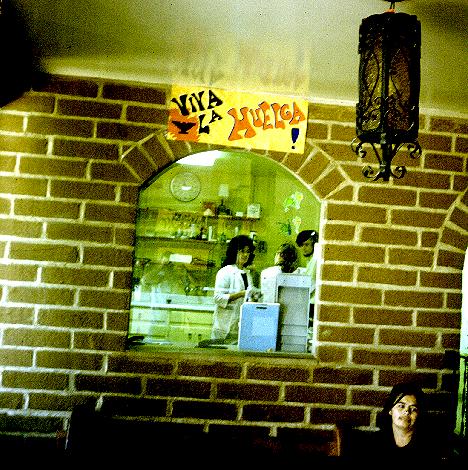 #102.
#102.
The 40 Acres health clinic intake window.
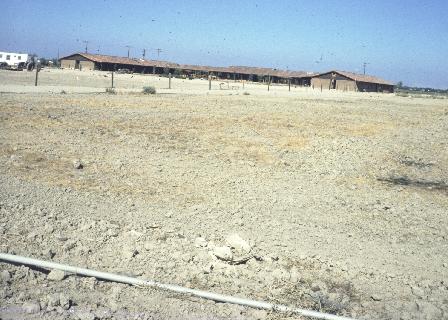 #108.
#108.
A long view of the retirement home being built at 40 Acres. Much of the construction labor was donated by
AFL-CIO union members--carpenters, plumbers, electricians, ... I don't know whether any materials were donated.
The first residents of the home would be the small group of Filipino farm workers seen in photo #88 above.
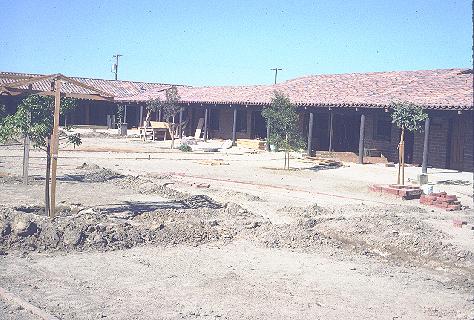 #109.
#109.
A closer view of the retirement home being built at 40 Acres.
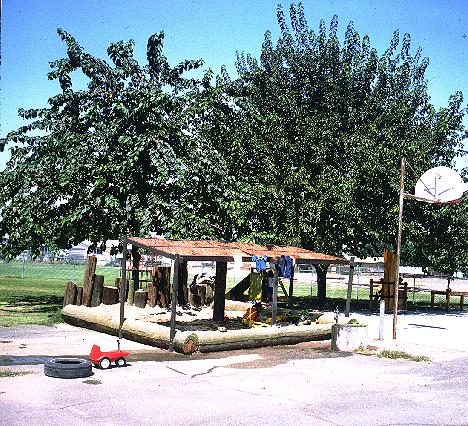 #114.
#114.
Play area at UFW-sponsored day care center.
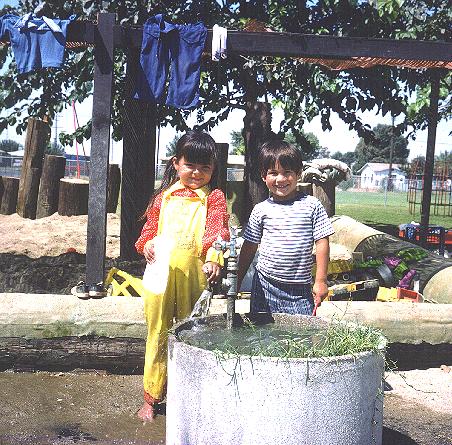 #115.
#115.
Two of the kids at the center. They are now in their mid-30s, at least.
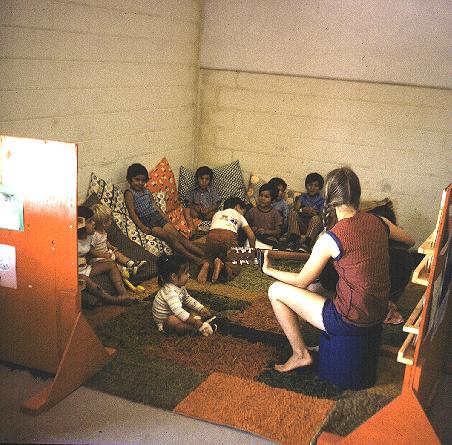 #116.
#116.
Farm worker children being serenaded by one of the many loving,
compassionate young men and women
who responded to the UFW's non-violent resistance to exploitation.
I believe this scene was just before nap time.
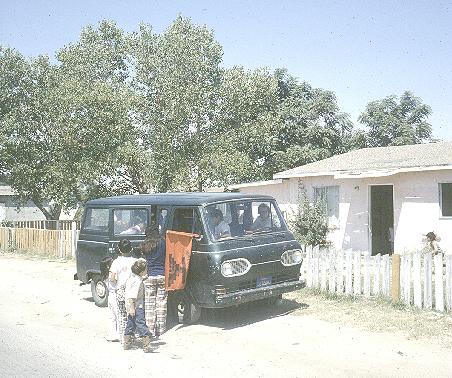 #121.
#121.
To the beach!!
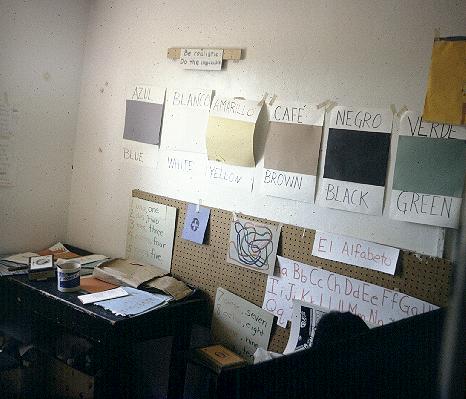 #123.
#123.
In the good ol' days, farm worker children didn't get an education,
thus ensuring that they would be available for exploitation later on.
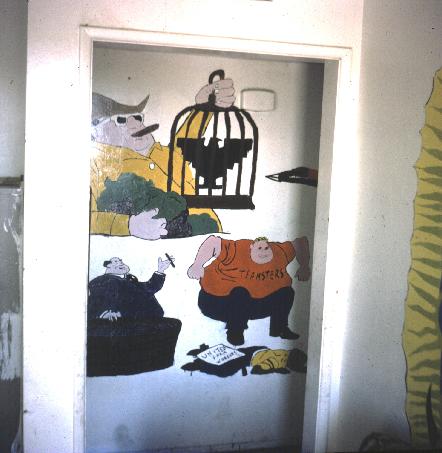 #124.
#124.
The perfect image to capture the essence of the "enemy." I use the term
"enemy" without apology or reservation. In his book Harvest Gypsies, John Steinbeck
uses a far stronger term. Steinbeck's research for Harvest Gypsies led directly to
Grapes of Wrath.